
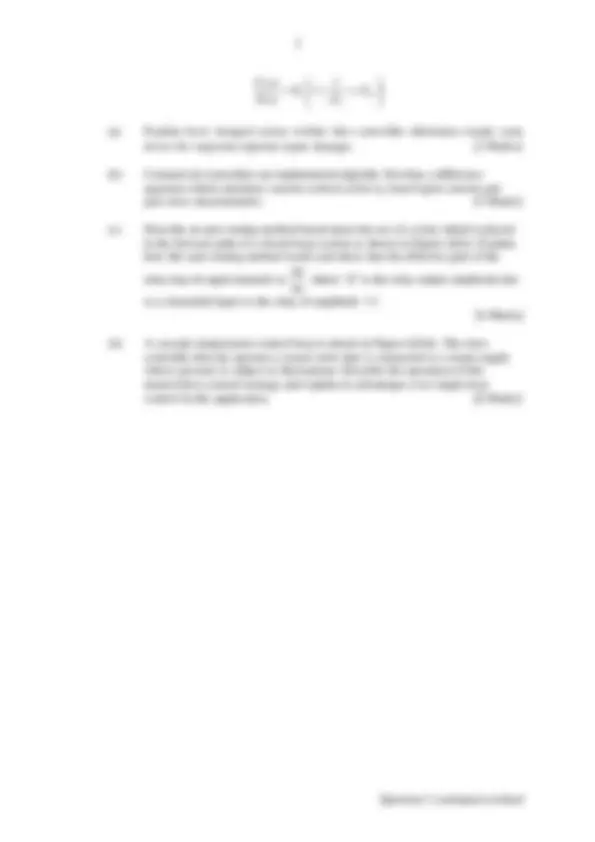
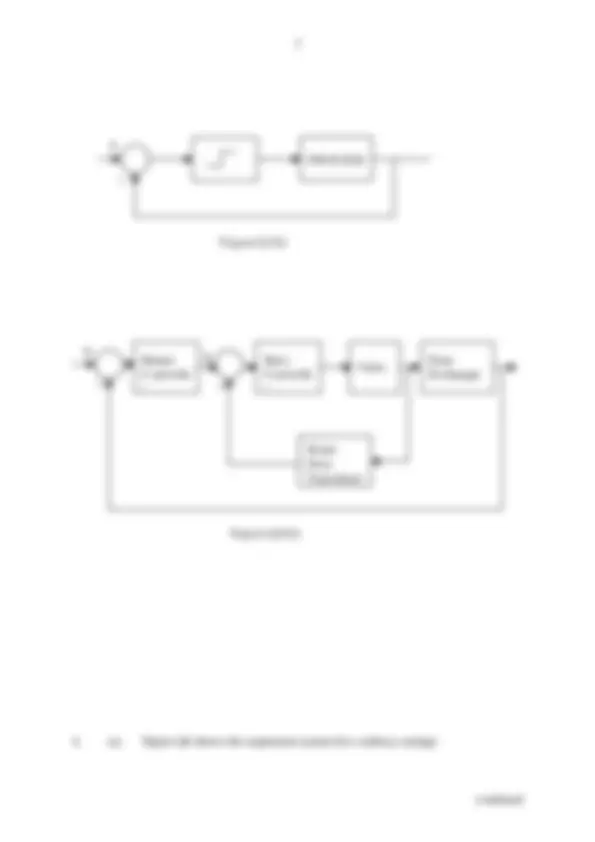
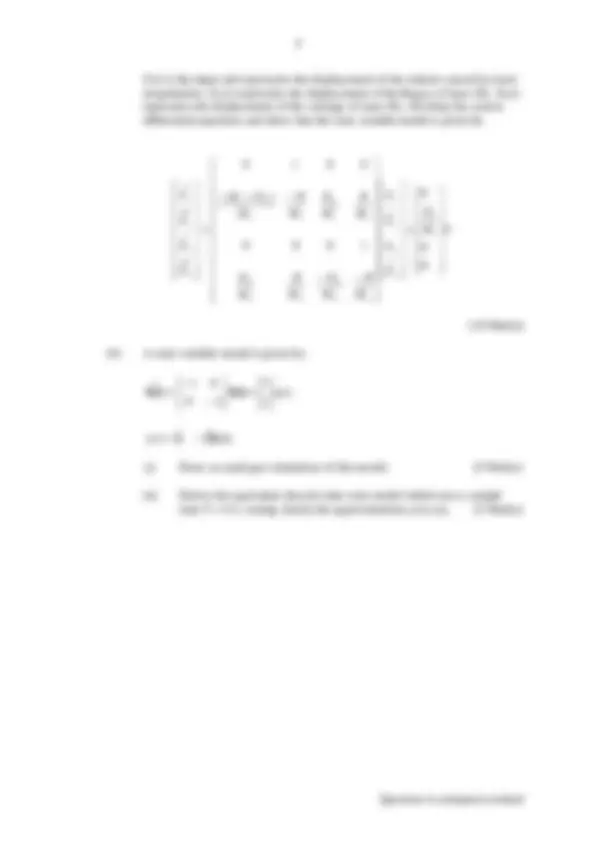
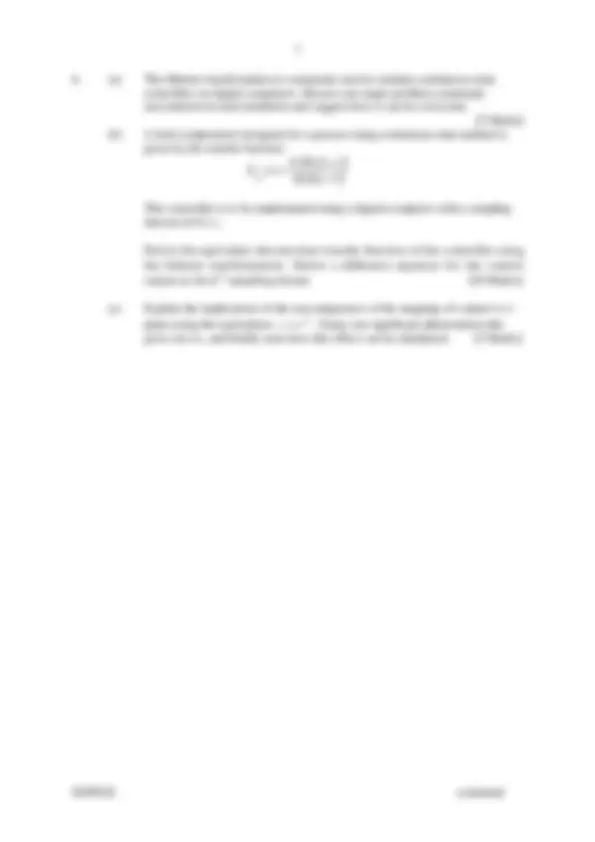
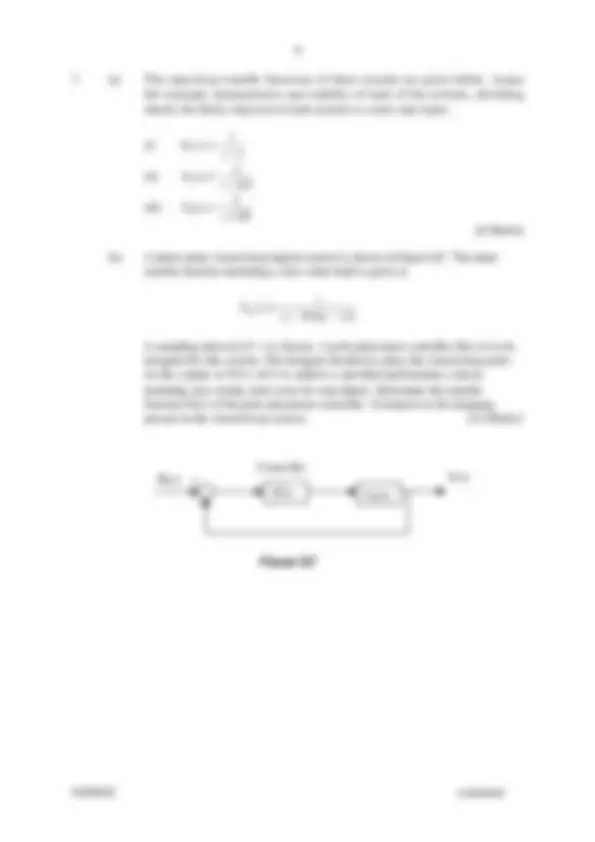
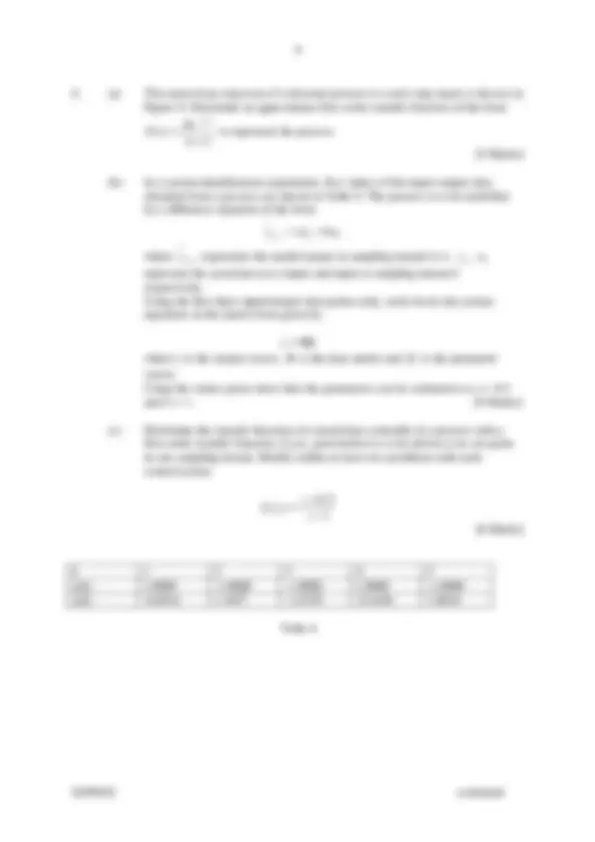


Study with the several resources on Docsity

Earn points by helping other students or get them with a premium plan


Prepare for your exams
Study with the several resources on Docsity

Earn points to download
Earn points by helping other students or get them with a premium plan
Community
Ask the community for help and clear up your study doubts
Discover the best universities in your country according to Docsity users
Free resources
Download our free guides on studying techniques, anxiety management strategies, and thesis advice from Docsity tutors
An examination for the beng (hons) electrical and electronic engineering degree program, specifically for the control engineering unit (64ee3013) in the fourth or fifth year of study. The exam consists of five questions, with not more than three from either section a or b. The questions cover various topics in control engineering, including root locus diagrams, lag compensators, pid controllers, digital control, and system modeling.
Typology: Exams
1 / 11

This page cannot be seen from the preview
Don't miss anything!







Examination for the BEng (HONS) ELECTRICAL AND ELECTRONIC ENGINEERING – FULL TIME BEng (HONS) ELECTRONIC ENGINEERING – PART TIME YEAR FOUR/FIVE
Friday 26 May 2000
2.00 pm to 5.00 pm
Instructions to Candidates
Answer FIVE questions with not more than three from either section.
Figure Q1, Figure Q2 and Jury Contours are provided on separate sheets.
Breakdown of marks for each question are shown in square parentheses.
continued
Section A
function (^)
s ss
s a G s K where K and a are controller parameters
with a = 0.5. The root locus diagram is shown in Figure Q1.
(a) What is the system type and what is the steady state error to reference ramp inputs on closed-loop? [4 Marks]
(b) Find the gain K required to reduce steady state errors to a reference parabolic input r ( t )= 21 t^2 to less than 1%. [4 Marks]
(c) Use the root locus diagram to assess the gain K required to give the closed- loop poles a damping ratio ζ = 0.5. With this gain can the system be regarded as dominantly second order? A separate sheet with Figure Q1 is provided for your use and this should be handed in with your Answer Booklet. [8 Marks]
(d) By reference to your answers in (b) and (c) above, discuss whether it is possible to select K and a to satisfy the design criteria for both ζ and the steady state requirements simultaneously. [4 Marks]
(b) (i) The open-loop frequency response for a process
ss s
G s is shown in Figure Q2.
Design a lag compensator s T
sT Gc s
( ) that will give steady state
errors due to ramp inputs of less than 5% and achieve a gain cross-over frequency (ωcg) of 1 rad s-1. [12 Marks]
(ii) Estimate the resulting phase margin and discuss whether additional phase lead compensation might be required. [4 Marks]
A separate sheet with Figure Q2 is provided for your use and this should be handed in with your Answer Booklet.
continued
Figure Q 3(i)
Master Controlle r
Slave Controlle r
Valve H eat Exch anger
Steam Flow Transducer
Figure Q 3(ii)
Question 4 continued overleaf
U(t) is the input and represents the displacement of the wheels caused by track irregularities; X 1 (t) represents the displacement of the Bogey of mass M 1 ; X 2 (t) represents the displacement of the carriage of mass M 2. Develop the system differential equations and show that the state variable model is given by:
1
1
2
2
1
1
2 2
2 2 2
2
1 1
2 1 1
1 2
2
2
1
1
[10 Marks]
(b) A state variable model is given by:
X t
X(t) X(t)
y t
ut
(i) Draw an analogue simulation of this model. [5 Marks]
(ii) Derive the equivalent discrete time state model which uses a sample time T = 0.2, stating clearly the approximations you use. [5 Marks]
02/09/02 continued
(i) A PID controller designed using continuous-time methods for a system with a bandwidth of 20 rad/s is to be emulated on a digital computer. [ Marks]
(ii) A minimum variance controller for a process with a dominant time- constant of 4 s is to be implemented in a direct digital control loop. [3 Marks]
(b) An open-loop system is described by the second-order difference equation yk = yk − 1 − 0. 25 yk − 2 + 0. 25 uk − 1
(i) Assuming zero initial conditions, calculate the response of the system over the first five sampling periods if a unit step input is applied to the system at time t = 0 s. [4 Marks]
(ii) Assuming z-1^ as the unit delay operator, determine the transfer function of the system and hence examine the system stability using pole-zero analysis in the z-plane. [5 Marks]
(iii) Mark the poles on the Jury contours and comment on the damping present in the system. Is the sampling rate chosen adequate for implementing a digital controller? [5 Marks]
02/09/02 continued
s
s s c
This controller is to be implemented using a digital computer with a sampling interval of 0.1 s.
D e rive th e equivalent discrete-tim e transfer function of th e controller using th e b ilinear transform ation. D e rive a difference equation for th e control output at th e k th^ sam pling instant. [10 Mark s]
(c) Explain the implications of the non-uniqueness of the mapping of s-plane to z- plane using the equivalence z = esT. Name one significant phenomenon this gives rise to, and briefly state how this effect can be eliminated. [5 Marks]
02/09/02 continued
−
s
Ke Gs
TD s
τ
to represent the process.
[5 Marks]
(b) In a system identification experiment, five values of the input-output data obtained from a process are shown in Table 8. The process is to be modelled by a difference equation of the form
y (^) k + = ayk + bu k
∧ 1
where (^) + 1
∧ y (^) k represents the model output at sampling instant k+1, y (^) k , uk represent the actual process output and input at sampling instant k respectively. Using the first three input/output data points only, write down the system equations in the matrix form given by
y =Φ β where y is the output vector, Φ is the data matrix and β is the parameter vector. Using the values given show that the parameters can be estimated as a = -0. and b = 1. [9 Marks]
(c) Determine the transfer function of a dead-beat controller if a process with a first-order transfer function, G 1 (z), given below is to be driven to its set-point in one sampling instant. Briefly outline at least two problems with such control action.
z
z G z
[6 Marks]
k 1 2 3 4 5 u(k) 1.0000 -1.0000 -1.0000 1.0000 -1. y(k) -0.6914 1.3457 -1.6729 -0.1636 1.
Table 8
0 2 4 6 8 10 12 14 16 18 20 22 24 26 28 30 32 34 36 38 40 42 44 46 48 50 52 54 56 58 60
0
1
2
3
4
5
6
7
8
9
Time s
Out
put
Figure 8